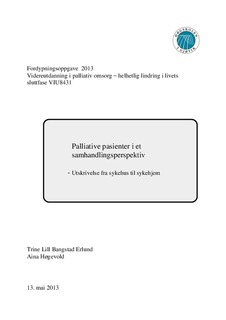| dc.contributor.author | Erlund, Trine Lill Bangstad | |
| dc.contributor.author | Høgevold, Aina | |
| dc.date.accessioned | 2013-07-02T08:24:47Z | |
| dc.date.available | 2013-07-02T08:24:47Z | |
| dc.date.issued | 2013 | |
| dc.identifier.uri | http://hdl.handle.net/11250/144574 | |
| dc.description.abstract | NORSK: Bakgrunn: Palliative pasienter opplever å flytte mellom behandlingsnivåer. Vi opplever i dag at det ofte er tilfeldigheter som avgjør hvor godt den palliative pasient blir ivaretatt ved overflytting. Etter innføring av samhandlingsreformen utskrives pasienter fra sykehus til sykehjem tidligere enn før. For å oppnå en bedre ivaretakelse av pasienten, stilles det krav til sykepleieres samhandlingskompetanse.
Hensikt: Hvordan kan sykepleiere samhandle for å ivareta den palliative pasienten ved overflytting fra sykehus til sykehjem?
Metode: Metoden er en litteraturstudie. Den er basert på fem kvalitative forskningsartikler, samt en fagartikkel. I tillegg benyttes teori og tidligere forskning, sammen med egne erfaringer fra praksis.
Resultater: Ut fra artiklene vi har inkludert i studien, fremkommer seks hovedfunn som bidrar til samhandling: Rolleavklaring/respekt, samarbeidsmøter, kommunikasjon, fellesundervisning/hospitering, dokumentasjon og personlig overrekkelse/besøk på sykehuset.
Konklusjon: Bedre rutiner omkring samhandling vil bidra til en bedre ivaretakelse av den palliative pasient. Resultatene i vår litteraturstudie er realistiske og gjennomførbare og bidrar til å oppfylle samhandlingsreformens krav til samhandlingskompetanse. | no_NO |
| dc.description.abstract | ENGLISH: Background: Palliative patients experience moving from one level of treatment to another. We experience that it’s often by chance how well the palliative patient is taken care of when transferred. After the introduction of the interaction reform, patients are discharged from hospital to nursing homes earlier. To achieve better care of the patient, more is demanded of nurses with regard to their competence to interact.
Aim: In what way can nurses interact to care for the palliative patient when being moved from hospital to nursing home?
Method: The method is a literary study. It is based upon five quality research articles, and one article on the subject. In addition we made use of theory and previous research, together with our experience from practice.
Results: On the background of the articles we have included in the study, six main findings which contribute to interaction. Role clarification/respect, co-operative meetings, communication, common teaching/shadowing, documentation and personal transfer/visiting the hospital.
Conclusion: Better routines regarding co-operation will contribute to improved care of the palliative patient. The results in our literary study are realistic and not too hard to carry out and contribute to attain the aims of the interaction reform with regard to competent co-operation. | no_NO |
| dc.language.iso | nob | no_NO |
| dc.subject | palliativ omsorg | no_NO |
| dc.subject | sykehjem | no_NO |
| dc.subject | samhandlingskompetanse | no_NO |
| dc.subject | kommunikasjon | no_NO |
| dc.title | Palliative pasienter i et samhandlingsperspektiv: utskrivelse fra sykehus til sykehjem | no_NO |
| dc.title.alternative | Palliative patients in an interactive perspective: discharge from hospital to nursing home | no_NO |
| dc.type | Student paper, others | no_NO |
| dc.subject.nsi | VDP::Medical disciplines: 700::Health sciences: 800::Nursing science: 808 | no_NO |
| dc.source.pagenumber | 38 | no_NO |
